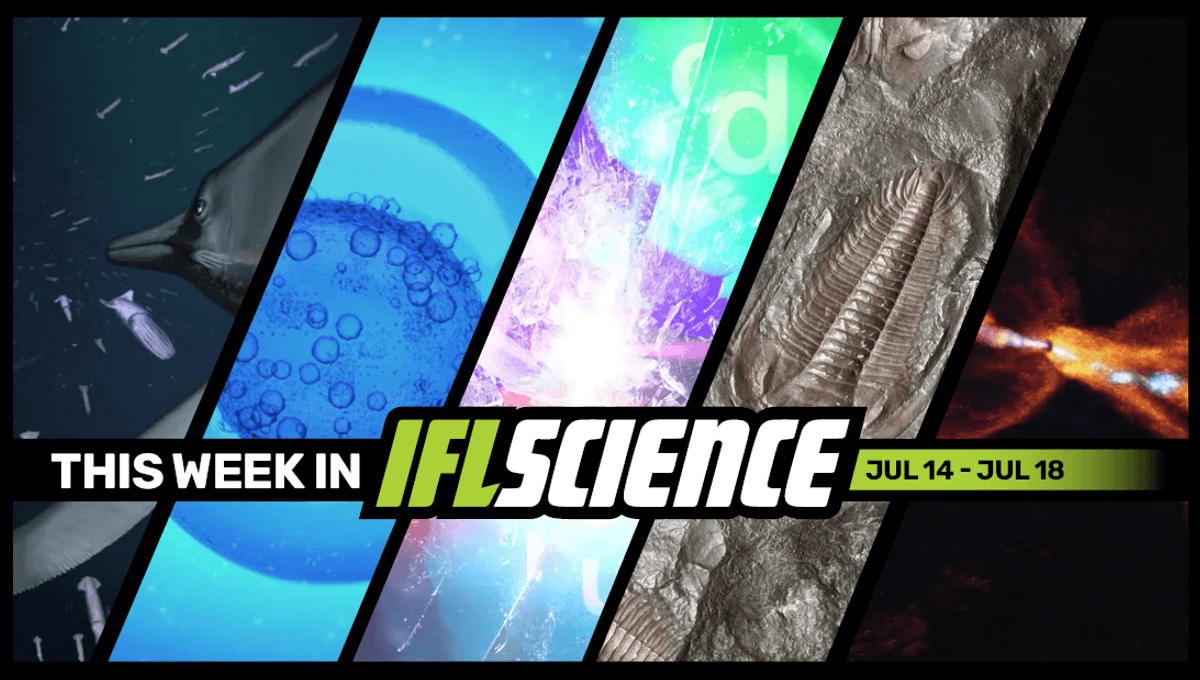
This week, scientists have, for the first time, observed matter-antimatter asymmetry in special particle decay, the first known trilobite fossil collected by Romans may have been used as a “magical” pendant or as a board game piece, and the “earliest moment” of planet formation has been spotted for the first time around a star 1,300 light-years away. Finally, we investigate whether we all need to be taking vitamin B12 supplements, or is it just a quick trip to expensive pee?
Create an IFLScience account to get all the biggest science news delivered straight to your inbox every Wednesday and Saturday.
First-Ever Giant Ichthyosaur Soft Tissues Preserved In “Extraordinary Fossil” Dating Back 183 Million Years
An extraordinary fossil has blown the socks off palaeontologists as it was found to contain the soft tissues of a Temnodontosaurus ichthyosaur, marking the first time we’ve ever found soft tissue remains of a giant ichthyosaur and introducing new-to-science features that reveal how they hunted. The discovery is going to revolutionize the way we look at ichthyosaurs, so said study co-author and palaeontologist Dr Dean Lomax, who knows a thing or two about these extinct marine reptiles. Read the full story here
8 Children Have Been Born With 3 Biological Parents Each After Mitochondrial Transfer
A technique to allow women who carry diseases in their mitochondrial DNA to have healthy children has been performed successfully eight times since being legalized, two papers have announced. With one pregnancy having led to identical twins, the work has led to eight healthy babies, as well as one pregnancy underway. Read the full story here
First Known Observations Of Matter-Antimatter Asymmetry In Special Particle Decay
Particles and antiparticles have opposite charges, and they annihilate if they interact, turning into pure energy. In the Big Bang, an equal amount of matter and antimatter formed, but some process must have given matter a boost, leaving just a tiny fraction of antimatter in the cosmos today. The reason for this is not clear, and several experiments are looking for an answer. The LHCb at CERN has just announced some incredible observations, taking us a step closer to it. Read the full story here
First Known Trilobite Fossil Collected By Romans Was Used As “Magical” Pendant
Excavations at a 2,000-year-old settlement in Spain have yielded the first ever trilobite fossil from Roman times. Found in a trash heap associated with a high-status household, the specimen appears to have been intentionally modified to form part of a necklace or bracelet, and was probably used as a magical pendant designed to protect its wearer. Read the full story here
“Earliest Moment” Of Planet Formation Spotted For First Time Around Star 1,300 Light-Years Away
The formation of planetary systems is not fully understood. There are many steps that require further observations, modeling, and theories. Stars form from clouds of gas and dust, and following star formation, that dust will crystallize into minerals, which will become pebbles, which might end up growing into planets. For the first time, researchers have observed the crystallization process. Read the full story here
TWIS is published weekly on our Linkedin page, join us there for even more content.
Feature of the week:
Vitamin B12: Do We All Need To Be Supplementing It?
Have you been feeling a little low in energy lately? Are you looking for a quick (ish) fix? Attempt to find a solution on the internet, and you may well be told to try a vitamin B12 supplement – but is that actually going to work? Or will it end up being a waste of your hard-earned cash? Read the full story here
More content:
Have you seen our e-magazine, CURIOUS? Issue 36 (July 2025) is available now. This month we asked, “How To Fake A Fossil” – check it out for exclusive interviews, book excerpts, long reads, and more.
PLUS, the We Have Questions podcast – an audio version of our coveted CURIOUS e-magazine column – continues. In episode 8, we ask, “Why Does Snow Sometimes Look Blue?”
The Big Questions podcast has returned, and we’re continuing season 5 with episode 3’s big question: How Do Black Holes Shape The Universe?
Source Link: “Extraordinary Fossil” Of Giant Ichthyosaur Dates Back 183 Million Years, 8 Children Have Been Born With 3 Biological Parents Each, And Much More This Week